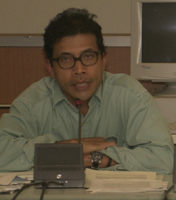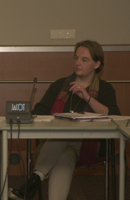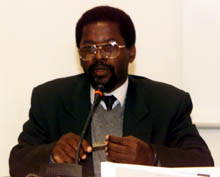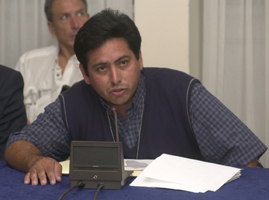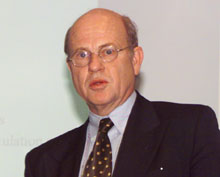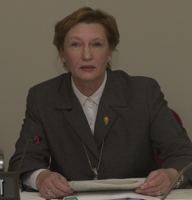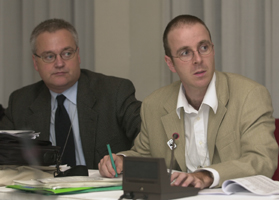|
| ||||
Monday 13 | Tuesday 14 | Wednesday 15 | Thursday 16 | Friday 17 | Saturday 18 | |
||||
|
Events convened on Monday 13 November 2000 |
||||
Tree Trouble: Why tree plantations as carbon sinks will cause social upheaval and environmental destruction presented by Fern
The controversy over the proposed role for forests as 'carbon sinks' under the Kyoto Protocol is tackled in "Tree Trouble: A compilation of testimonies on the negative impact of large-scale tree plantations", a report compiled by Friends of the Earth International in co-operation with the World Rainforest Movement, Fern and the Future in Our Hands. The report was the focus of the debate at this side event. Jutta Kill, Fern, United Kingdom, introduced case studies and argued that there will be substantial social and cultural consequences of large-scale tree plantations in the tropics if they are established in the name of climate change. Javier Baltodano, Coecoceiba, Costa Rica, spoke about the loss of biodiversity through monoculture plantations. Ricardo Carrere, World Rainforest Movement, reiterated the risks of plantations exacerbating poverty and creating conflicts over resources. Larry Lohmann, Cornerhouse, United Kingdom, referred to carbon accounting as "scientific fraudulence". Hendro Sangkoyo of the Consortium for Community Forest Systems, Indonesia, speaking on biodiversity and indigenous rights, stressed that sinks should not be included under the CDM. Simone Lovera, Friends of the Earth International, emphasized the need to incorporate social and cultural dimensions when defining forests. In conclusion, Jutta Kill urged developed countries to contribute financially to relieve the ecological debt by means other than the CDM. Discussion: The argument was put forward that excluding sinks from the CDM would be equivalent to "throwing the baby out with the bath water" and it was suggested that the inclusion of sinks be used to the advantage of the poorest rural communities in developing countries. Concern was raised that the negotiating process lacked a sense of urgency and the proposed inclusion of sinks was only avoiding the inevitable need to cut fossil fuel emissions in developed countries. For more information: |
||||
|
CC:Forum on National Communicationsfrom Non-Annex I Parties presented by UNFCCC consultative group of experts. Representatives from a number of Parties who have submitted National Communications delivered presentations about their experiences. They were Mirzakhan Mansimov, Azerbaijan, Mama Konate, Mali, Valentin Ciubotaru, Moldova, and Manuel Leáo Silva Carvalho from Cape Verde. They reported on: limited domestic research resources, including trained staff and equipment; gaps in the availability of data, which sometimes necessitate a deviation from IPCC guidelines; and the development of methodology to measure arable soil emissions. Discussion: During a brief discussion, a representative from the Republic of Panama raised the problem of maintaining domestic research capacity after the completion of initial National Communications. A representative of the UNDP-GEF announced details of a workshop on a preliminary draft Framework for Adaptation Measures and Strategies in a Policy Context on 14 November at COP-6. A workshop on 15 November will provide a general update on a proposed UNDP approach to improving GHG inventories through a regional approach. More information: |
||||
|
The Challenge of Japanese Industry Voluntary Action Plan for Hosoya highlighted the development of legal frameworks, including the adoption of Guidelines for Measures to prevent Global Warming (1998), which set the path for the national climate change policy up to 2010, and the enactment of a Law for the Promotion of Measures to Cope with Global Warming (1998). He described measures to promote energy conservation in industry, transport, and the commercial and residential sectors, through the improvement of energy efficiency, the promotion of renewable energy and the utilization of nuclear power. He underlined the importance of voluntary initiatives because they facilitate best practice and enhance self-responsibility and cost effective actions. He explained that Japan's VAP aims to set overall targets to reduce CO2 emissions from industry and energy-conversion sectors to below 1990 levels by 2010. He concluded with a report on downward emissions trends within some industrial sectors participating in the VAP. On the Kyoto Mechanisms, he advocated the need for a "learning by doing" process, wide participation by the private sector, "fungibility" of credits between JI/CDM projects, and the need to create national registration systems for the transfer of emission allowances/credits. He underlined the importance of supplementarity and opposed any system of compulsory initial allocation of emission permits (caps), noting that such an approach would be strongly opposed by industry. Discussion: Participants discussed the effectiveness of voluntary plans and the inclusion of nuclear energy in the CDM. Hosoya advocated the inclusion of nuclear energy projects in the CDM. More Information: |
||||
|
Forest carbon, rural livelihoods, and communities presented by The Nature Conservancy
(TNC)
Discussion: The ensuing discussion highlighted the controversies and remaining uncertainties regarding the inclusion of forests under the CDM and whether benefits will accrue to the poorest communities in developing countries. Greenpeace stressed the risk of Annex I Parties avoiding their responsibility for reducing domestic emissions. Aquiles Neuenschwander, Delegation of Chile, highlighted that deforestation and land use change contribute 20-25% of global carbon emissions. Márcio Santilli, Instituto Socioambiental, Brazil, contended that 17 NGOs and 14 individuals have signed a manifesto in Brazil supporting the inclusion of forests under the CDM. More information: |
||||
|
Key messages from the Intergovernmental Panel on Climate Change special reports on
technology transfer and emission scenarios presented by the Intergovernmental Panel on Climate Change
The IPCC found three dimensions that make technology transfers more effective. First, people and organizations need to continuously adapt to new circumstances and acquire new skills. A focus on human and organizational capacity building will improve the chances that new technologies will be adapted successfully. A second dimension identified by the IPCC is the need for an enabling environment. Government, through, inter alia, sound policy and regulatory frameworks, transparency and political stability, can create an enabling environment for public and private sector technology transfers. The third dimension is the National Systems of Innovation (NSI). Dr. Metz underlined the importance of NSI as mechanisms for promoting technology transfers. NSI are based on a loosely organized system focused on establishing partnerships and integrating capacity building, access to information and an enabling environment. IPCC scenarios (SRES), Professor Nebojsa Nakicenovic, International Institute for Applied Systems Analysis (IIASA), outlined the goals and methodology of the study. The scenarios are based on a thorough review of the literature and follow a similar assessment conducted in 1992. Acknowledging that GHG emissions are the product of very complex dynamic systems, the SRES report presents four storylines to describe the relationships between emission-driving forces, and models the projected emissions. A narrowing of income differences is assumed in many of the SRES scenarios, and recent global population projections are generally lower than those in the 1992 scenarios. While no probability is assigned to any of the scenarios, he concluded that the total cumulative SRES carbon emissions from all sources through 2100 range from approximately 770 - 2540 GtC. More information: |
||||
|
EIT countries: Moving ahead with the implementation of the Kyoto Protocol
presented by the Organisation for Economic Co-operation and Development
(OECD) and the International Energy Agency (IEA)
Ingrida Apene, Ministry of Environment, Latvia, provided a summary of findings in a survey sent to several countries to assess their capacity building needs. All respondents reported that institutions, infrastructure, and training are the key capacity building issues. For example, many countries have reported incomplete inventories, particularly for non-energy emission sources, and lack capacity to follow IPCC guidance on inventory methodologies. On the Latvian experience, she noted that valuable experience had been gained in the recent past, and emphasized that high transaction costs may undermine the success of smaller projects. Professor Sadowski, National Fund for Environment Protection and Water Management, outlined the experience of Poland in establishing baselines for JI projects. He argued against the use of benchmarks when establishing baselines because such standards do not reveal the large differences between individual projects. On allocating the assigned amounts to different sectors, he emphasized that this was a political decision, regardless of reporting problems. On capacity building in Bulgaria, Valja Peeva, EnEffect, noted differences in reporting methodologies, a lack of institutions and staff with appropriate capacity, and the lack of cooperation with private companies, and stressed the need for permanent staff and increased funding. Bill Irving, United States delegation, speaking on behalf of UNITAR, highlighted a proposal to support the establishment of permanent GHG inventory systems in EITs. He stressed that much expertise exists within EITs, but this experience requires broadening through training and establishing regional networks of experts. In concluding the session, Anca-Diana Barbu, OECD, stressed the continuing work helping EITs meet their obligations under the Kyoto Protocol. Discussion: The discussion focused on Croatia's difficulties in meeting its Kyoto Protocol targets, the role of the EU if EITs decide to apply for accession, and the role of experts employed by NGOs in the Russian Federation. More information: |
||||
| |
A Streamlined CDM Process for Solar Energy Systems in Rural Homes
presented by the Netherlands Energy Research Foundation (ECN), Sunrise Technologies Consulting and IT Power
The ECN together with IT Power and Sunrise Technolgies Consulting, presented ideas for a streamlined CDM process for PV solar home systems (SHS), which are small solar electricity systems for stand-alone applications in rural areas of developing countries, powered by a photovoltaic (PV) module. The presentation assessed the key factors determining emissions reductions and additionality based on a range of SHS projects.
More Information:
Download the report at: http://www.ecn.nl/unit_bs/kyoto/mechanism/cdmshs.html http://www.panda.org/epo/ http://www.erm.com/ Contact: Remko Ybema, ECN Policy Studies <ybema@ecn.nl> |
| © 2000, IISD. All rights reserved. |
|



